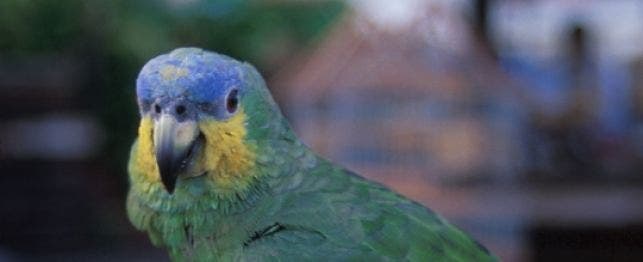
Choosing an Orange-winged Amazon
Orange-winged Amazons (Amazona amazonica) are medium-sized, stocky green birds that measure about 11 to 13 inches long. Their faces are variably colored with blue, yellow and sometimes orange. Their beaks are colored a dark horn shade, with a black tip. Primary and secondary flight feathers are green with blue tips; tail feathers, green with orange panels on the outer feathers and yellowish-green tips.
These birds – which can probably live 50 to 60 years or more – are distinguished from the similar blue-fronted Amazon by a yellow marking on the forehead surrounded by blue (blue-fronts have a blue marking, typically surrounded by yellow). The birds are named for their orange wing speculum – another difference that sets them apart from blue-fronts, which have a red wing speculum.
Males are generally larger than females and have larger heads and beaks; they also tend to be slightly more colorful. Juveniles have brown eyes, which change to orange-yellow at adulthood. When young, the birds are a paler green and have less extensive facial coloring.
During the 1970s and 1980s, large numbers of orange-wings were imported into the United States, but since they are difficult to breed, they are uncommon in today’s market. Intelligent, inquisitive birds, they tend to be more shy than other, more popular species. They have moderate to poor speaking ability. However, when they are available, juveniles make good, tame pets.
Like most Amazons, orange-wings like to play, so they should be provided with toys, blocks of wood or branches that they can chew. In general, young Amazons should be socialized to many people and exposed to a variety of situations, such as new cages, toys, visits to the veterinarian, handling by friends, wing and nail clips, etc. to avoid fear of novel situations.
In the wild, the orange-wings’ range is widespread in northern South America — mostly east of the Andes, from Colombia to southeastern Brazil. The birds inhabit many types of lowland forest, savannah and seasonal floodplain habitat. They nest in tree cavities, feeding on tree seeds, new leaves, palm fruits, berries, pods, fruits, acorns and buds. They are frequently found at forest edges and often around cities; occasionally, they cause crop destruction, especially to corn crops.
Feeding
Amazons should be fed a formulated (pelleted or extruded) diet. The diet should be supplemented with fresh fruits and vegetables daily to add variety and psychological enrichment. Feed approximately 1/4 to 1/3 cup of formulated diet and 1/4 to 1/3 cup of fresh fruits and vegetables daily. Monitor food intake as overfeeding leads to pickiness, selective feeding and wasteful food throwing. Because of their tendency to obesity, orange-winged Amazons should be fed few sunflower or safflower seeds, even as treats. Vitamin supplements are not needed for birds eating a formulated diet.
Birds that are fed only seeds need vitamin and mineral supplementation to prevent deficiency diseases. Vitamins should be added to soft food rather than to water, as it dilutes the vitamins. In addition, water-soluble vitamins break down rapidly, and water contaminated with the sweeteners that are usually added to vitamins is a good growth medium for bacteria. Vitamins added to the outside of seeds are usually lost when the bird shells the seeds.
Grooming
Routine bathing or showering is vital to maintaining good plumage and skin condition. Birds can be misted and allowed to dry in a warm room or in the sun, or can be gently dried with a blow drier. Care should be taken not to clip the wing feathers excessively as heavy-bodied Amazons such as orange-wings often fall and injure themselves. Clip only the primary flight feathers and only enough so the bird will glide to the floor.
Housing
Orange-winged Amazons are very active and should be provided the largest cage that space and budget allow – one that will provide room for flight. They should also be supplied with a retreat to guard against insecurity and fear responses. Ideally, the bird should also have an outdoor cage to allow playtime in the fresh-air and sunlight.
While durable cage construction is not as critical as it is for macaws and cockatoos, locks or escape proof latches may be necessary on cages.
Breeding
Orange-winged Amazons are relatively difficult to breed in captivity. In North America they breed predominantly in the spring and have a limited breeding season, from February or March to June or July. Clutch size is typically three to four eggs. Incubation period is approximately 24 to 26 days. Chicks usually fledge at approximately 10 to 12 weeks of age. Orange-winged Amazons are relatively easy to hand-rear and most hand-rearing formulas can be used successfully.
For a breeding cage, 1 inch by 1 inch 14-gauge welded wire is a good choice for cage construction. A suggested size is 8 feet by 4 feet by 4 feet suspended 4 feet above the ground or floor.
Grandfather-style wooden nest boxes can be used. Size should be approximately 12 inches by 12 inches by 24 inches.
Male orange-wings are seldom aggressive toward their mates, but in some cases clipping the male’s wings prior to the breeding season may be necessary to help the female to escape in case the male becomes aggressive.
Orange-wings can be noisy when in breeding condition. When breeding Amazons, noise and proximity to neighbors must be considered.
Common Diseases and Disorders
Amazons are relatively healthy birds but are susceptible to the following:
- Feather-picking
- Psittacosis
- Obesity
- Poor eating habits
- Bacterial and fungal infections
- Toxicity, ingestion of metals